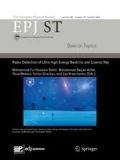Abstract
We study the ground entangled state of the one-dimensional spin-1/2 Ising ferromagnet at its transverse-field critical point. When this problem is expressed in terms of independent fermions, we show that the usual thermostatistical sums emerging within Fermi-Dirac statistics can, for an L-sized subsystem, be indistinctively taken up to L terms or up to lnL terms, providing a neat understanding of the origin of the logarithmic scaling of the entanglement entropy in the system. This is interpreted as a compact occupancy of the phase-space of the L-subsystem, hence standard Boltzmann-Gibbs thermodynamics quantities with an effective system size V ∝ lnL are appropriate and are explicitly calculated. The calculations are then to be done in a Hilbert space whose effective dimension is 2ln L instead of 2L. In this we can assume ergodicity. Our analysis suggests a scenario where the physical systems are essentially grouped into three classes, in terms of their phase-space occupancy, ergodicity and Lebesgue measure.
Similar content being viewed by others
References
L.E. Reichl,A Modern Course in Statistical Physics, 3rd edn. (John Wiley & Sons, New York, 2009)
R.G. Palmer, Adv. Phys. 31, 669 (1982)
H. Kestelman,Modern Theories of Integration, 2nd edn. (Dover, New York, 1960)
U. Tirnakli, E.P. Borges, Sci. Rep. 6, 23644 (2016)
C. Tsallis, J. Stat. Phys. 52, 479 (1988)
M. Pouranvari, K. Yang, Phys. Rev. B 89, 115104 (2014)
Z.-C. Yang, C. Chamon, A. Hamma, E.R. Mucciolo, Phys. Rev. Lett. 115, 267206 (2015)
C.R. Laumann, A. Pal, A. Scardicchio, Phys. Rev. Lett. 113, 200405 (2014)
C. Holzhey, F. Larsen, F. Wilczek, Nucl. Phys. B 424, 443 (1994)
G. Vidal, J.I. Latorre, E. Rico, A. Kitaev, Phys. Rev. Lett. 90, 227902 (2003)
A.R. Its, B.-Q. Jin, V.E. Korepin, J. Phys. A 38, 2975 (2005)
J.I. Latorre, E. Rico, G. Vidal, Quantum Inf. Comput. 4, 48 (2004)
P. Calabrese, J. Cardy, J. Stat. Mech. Theory Exp. 2004, P06002 (2004)
L. Amico, R. Fazio, A. Osterloh, V. Vedral, Rev. Mod. Phys. 80, 517 (2008)
R. Islam, R. Ma, P.M. Preiss, M.E. Tai, A. Lukin, M. Rispoli, M. Greiner, Nature 528, 77 (2015)
P. Pfeuty, Ann. Phys. 57, 79 (1970)
S. Sachdev,Quantum Phase Transitions (Cambridge Universuty Press, Cambridge, 1999)
F. Franchini, A.R. Its, V.E. Korepin, J. Phys. A 41, 025302 (2008)
M.B. Hastings, I. Gonzales, A.B. Kallin, R.G. Melko, Phys. Rev. Lett. 104, 157201 (2010)
R. Horodecki, P. Horodecki, M. Horodecki, K. Horodecki, Rev. Mod. Phys. 81, 865 (2009)
F. Caruso, C. Tsallis, Phys. Rev. E 78, 021102 (2008)
B.-Q. Jin, V.E. Korepin, J. Stat. Phys. 116, 79 (2004)
I. Peschel, J. Stat. Mech. Theory Exp. 2004, P06004 (2004)
H. Fukuyama, R.A. Bari, H.C. Fogedby, Phys. Rev. B 8, 5579 (1973)
M. Saitoh, J. Phys. C Solid State Phys. 6, 3255 (1973)
E.E. Mendez, F. Agullo-Rueda, J.M. Hong, Phys. Rev. Lett. 60, 2426 (1988)
L. Gutierrez, A. Diaz-de-Anda, J. Flores, R.A. Mendez-Sanchez, G. Monsivais, A. Morales, Phys. Rev. Lett. 97, 114301 (2006)
E.O. Kane, J. Phys. Chem. Solids 12, 181 (1959)
G.H. Wannier, Phys. Rev. 117, 432 (1960)
C.M. Herdman, P.-N. Roy, R.G. Melko, A. Del Maestro, Nat. Phys. 13, 556 (2017)
P. Calabrese, M. Mintchev, E. Vicari, Europhys. Lett. 97, 20009 (2012)
C. Tsallis, Eur. Phys. J. Special Topics 226, 1433 (2017)
C. Tsallis, Braz. J. Phys. 39, 337 (2009)
C. Tsallis,Introduction to Nonextensive Statistical Mechanics (Springer, Berlin, 2009)
Author information
Authors and Affiliations
Corresponding author
Rights and permissions
About this article
Cite this article
Souza, A.M.C., Rapčan, P. & Tsallis, C. Area-law-like systems with entangled states can preserve ergodicity. Eur. Phys. J. Spec. Top. 229, 759–772 (2020). https://doi.org/10.1140/epjst/e2020-900003-3
Received:
Revised:
Published:
Issue Date:
DOI: https://doi.org/10.1140/epjst/e2020-900003-3



